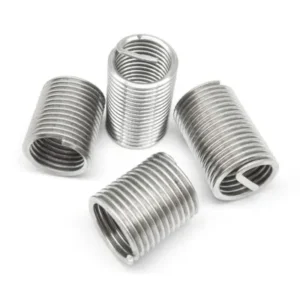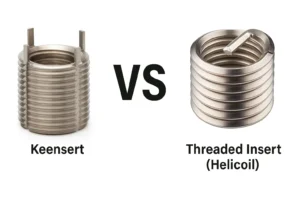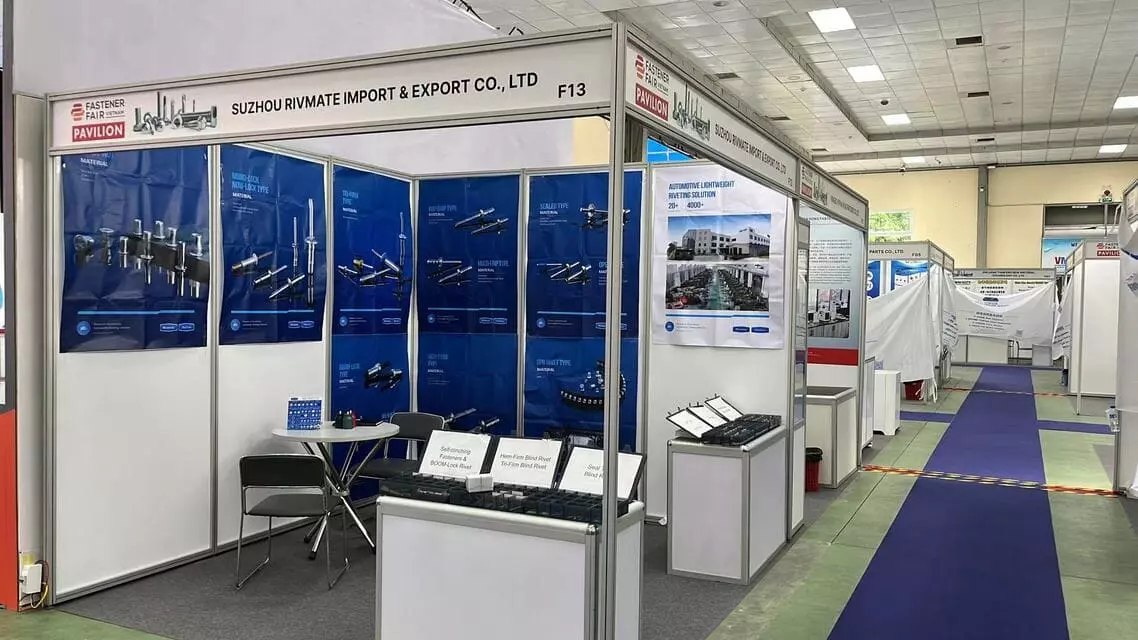What is a Self Clinching Nut / Pem Nut?
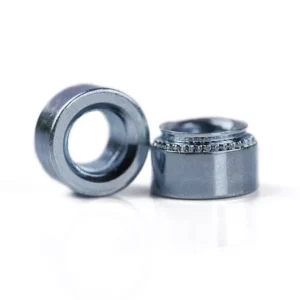
Leading Self-Clinching Fasteners Manufacturer and Supplier in China
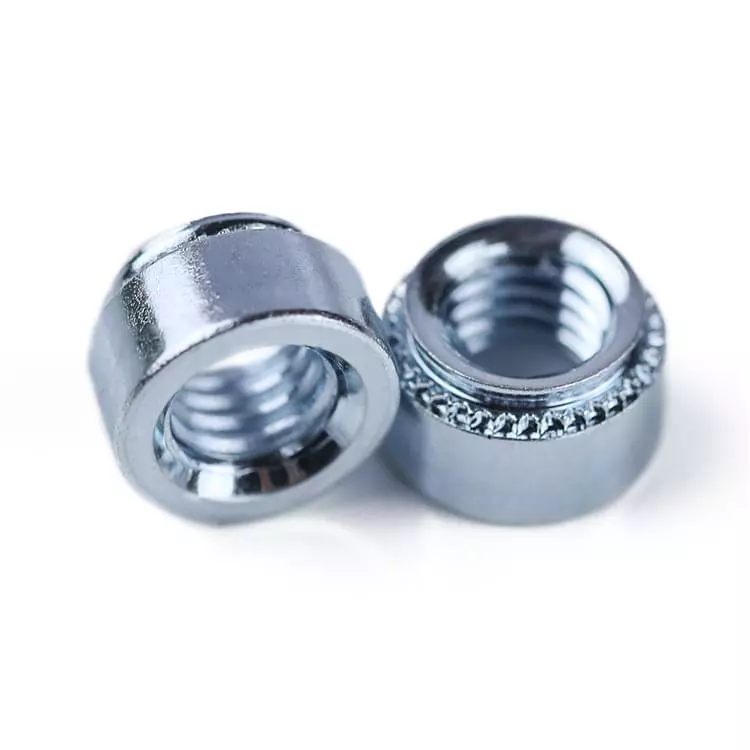
What is a Self Clinching Nut ? The Self Clinching Nut (commonly known as Pem Nut®, after the industry-leading brand PennEngineering) has revolutionized sheet metal assembly by eliminating the need for welding or secondary fasteners.
This guide dives into their working principles, key advantages over traditional fastening methods, and critical application scenarios—plus tips to avoid common installation pitfalls. Let’s decode why this tiny component is a giant in precision manufacturing.
Table of Contents
What is a Self Clinching Nut/Pem Nut?
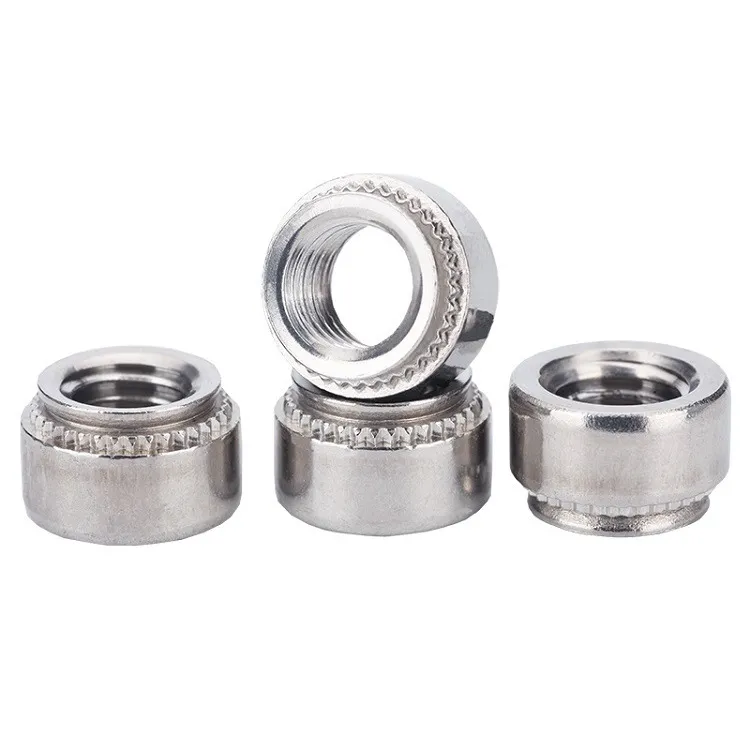
A self-clinching nut (also known generically as a PEM Nut®) is a permanent fastener designed to embed into ductile materials (e.g., sheet metal, thin plates). They through a press-in installation process, creating a load-bearing threaded hole.
Structure:
- Annular Ring (Knurled Collar): Serrated edges to prevent rotation after installation.
- Piloting Feature: Aligns with pre-punched holes.
- Threaded Shank: Accepts screws/bolts.
Materials & Finishes:
- Base Metals: Stainless steel (SS 304/316), carbon steel (zinc-plated), hardened stainless steel.
- Coatings: Passivation, zinc-nickel plating, or powder coating for corrosion resistance.
PEM Nut® Note
“PEM Nut” is a registered trademark of PennEngineering®, though widely used generically (similar to “Velcro”). Always specify true PEM® products for mission-critical applications.
TL;DR: A self-clinching nut embeds permanently into sheet metal, providing durable threads without welding.
Why Use Self Clinching Nuts?
1. Single-Sided Installation, No Backside Operation Needed
- Easy Application: Installed by applying pressure from one side of the panel, eliminating the need for backside access in confined or enclosed spaces (e.g., welding or tightening a nut).
- Fewer Assembly Steps: Ideal for applications where the backside is inaccessible after assembly, such as sealed enclosures or automotive chassis panels.
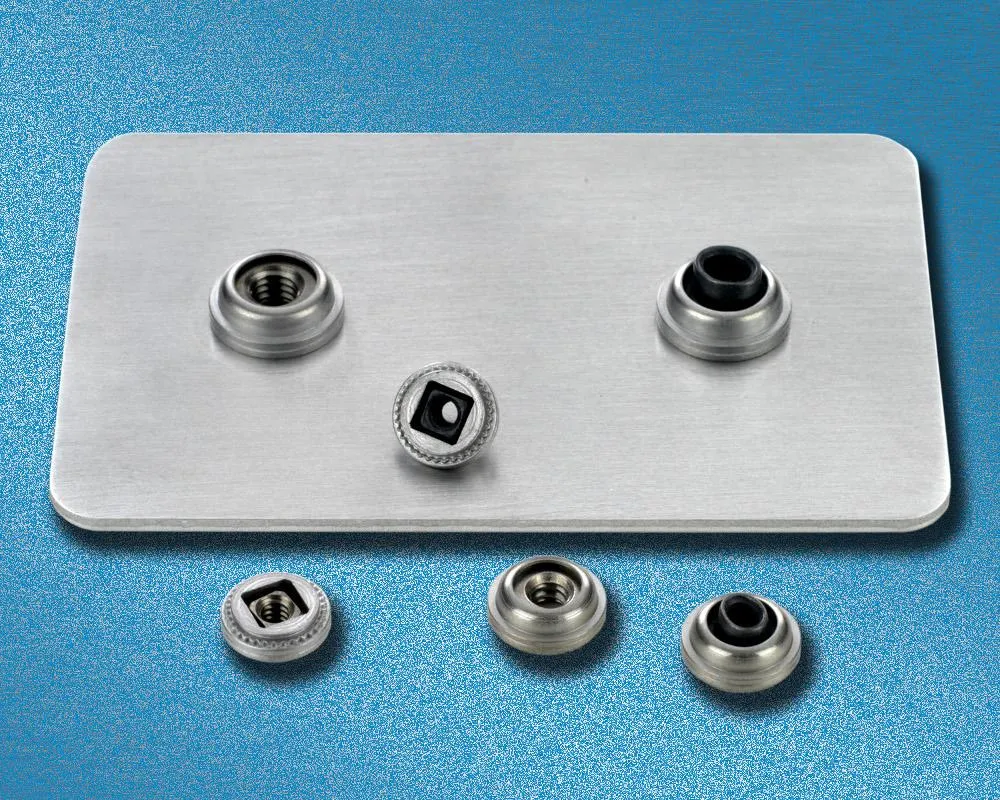
2. High Pull-Out and Torque Resistance
- Mechanical Interlock: The plastic deformation of the panel wraps around the knurled or serrated structure of the nut, creating a permanent anchor.
- High Load Capacity: Withstands strong vibrations and dynamic loads (e.g., pull-out strength in automotive suspension components can reach 10-20 kN).
3. Lightweight and Space-Efficient Design
- Thin Sheet Compatibility: Suitable for panel thicknesses ranging from 0.5 to 6mm, supporting lightweight designs in aerospace and new energy vehicles.
- No Extra Components: Eliminates the need for traditional bolts, washers, adhesives, or additional fasteners, reducing part count and weight.
4. Increased Production Efficiency & Lower Overall Costs
- Fast Installation: The press-fit process takes only a few seconds, compared to several minutes for traditional welding, making it ideal for mass production.
- No Additional Consumables: No need for welding materials, adhesives, or complex tooling, reducing long-term labor and maintenance costs.
5. Broad Material & Environmental Adaptability
- Multi-Material Compatibility: Works with steel, aluminum, stainless steel, and engineered plastics (special models required).
- Corrosion & Weather Resistance: Zinc plating (salt spray resistance), passivation (stainless steel), and anodizing (aluminum) treatments allow usage in high-temperature and humid environments (e.g., marine or chemical equipment).
6. Smooth & Aesthetic Surface Finish
- Flush-Mounted Design: Installs flush with the panel surface, eliminating protrusions or sharp edges, making it suitable for applications with high aesthetic requirements (e.g., consumer electronics, medical devices).
- Minimal Coating Interference: Can be installed before painting, preventing coating damage around screw holes.
Comparison Summary (vs. Traditional Fastening Methods)
Core Value:
Self-clinching nuts provide a structural innovation and streamlined process, addressing the efficiency, reliability, and lightweight challenges of traditional fasteners—making them the preferred choice for modern industrial design.
| Criteria | Self-Clinching Nuts | Traditional Nuts/Welding |
|---|---|---|
| Installation Speed | 5–10 seconds per unit | 1–5 minutes per unit (including welding & cooling) |
| Vibration Resistance | Mechanically locked, maintenance-free for life | Requires periodic inspection & reinforcement |
| Panel Thickness | Recommended: 0.5–6mm | No strict limitations |
| Long-Term Cost | Low maintenance, high consistency | High labor & rework costs |
How to Install Self Clinching Nuts?
a. Core Working Principle
- What Gets Locked? The knurling or annular serrations on the outer surface of the self-clinching nut.
- How It Works? Applied pressure forces the sheet metal to flow into the nut’s grooves, creating a physical interlock.
- Final Effect? The nut becomes “wrapped” by the sheet metal, preventing rotation and axial movement.
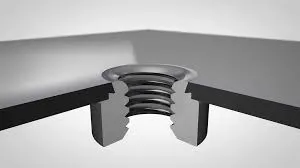
b. The Essence of Self-Clinching Nut Installation
Common Misconception:
Applying direct force to the nut (e.g., hammering) may damage the nut’s threads or cause cracks, especially in brittle materials like carbon steel.
Correct Installation Process:
- Step 1: Place the self-clinching nut into the pre-drilled hole (hole diameter slightly smaller than the nut’s outer diameter).
- Step 2: Apply vertical pressure using a press tool, ensuring the press head contacts only the sheet metal, not the nut itself.
- Step 3: Under pressure, the sheet metal undergoes plastic deformation, flowing into the nut’s serrations or knurling, forming a secure mechanical interlock.
Analogy: Like wrapping a filling inside dough—your fingers apply pressure to the dough (sheet metal), forcing it to enclose the filling (nut’s serrations), creating a secure lock.
c. Specialized Design of Installation Tools
- Press Head Shape:
Typically flat or grooved to match the nut’s head, ensuring even pressure distribution and preventing localized stress that could tear the sheet metal. - Pressure Parameters:
Pressure settings must be adjusted based on sheet metal material, thickness, and nut specifications. Examples:- 1.5mm aluminum sheet + stainless steel nut → ~5-8 tons of pressure
- 3mm carbon steel sheet + zinc-plated nut → ~12-15 tons of pressure
d. Consequences of Incorrect Installation
- Direct Force on the Nut:
Nut deformation: An M4 metric thread was crushed by incorrect pressing, making it impossible to insert a screw.
Sheet metal failure: Excessive force at the nut’s edge caused the panel to collapse, creating burrs. - Misaligned Press Head:
If the press head is not centered, the sheet metal deforms unevenly → the nut gets misaligned → pull-out strength is reduced by over 50%.
e. Key Concepts for Proper Installation
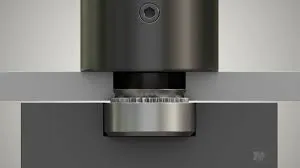
- The sheet metal is the active participant: Its flow and ductility (e.g., aluminum is more malleable than high-carbon steel) directly affect the installation outcome.
- The nut is the passive locking component: It only provides the knurling/serrations as an anchoring point and does not bear the main pressure.
f. Additional Notes: Suitable Sheet Thickness Range
Self-clinching nuts require specific sheet thicknesses. If too thin, the interlock is insufficient; if too thick, deformation becomes difficult. Common compatible thicknesses:
| Nut Type | Suitable Sheet Thickness |
|---|---|
| M3 Thin-Type Self-Clinching Nut | 0.8–2.0 mm |
| M5 Standard Self-Clinching Nut | 1.5–3.0 mm |
| M8 Heavy-Duty Self-Clinching Nut | 2.0–6.0 mm |
Do You Have Any Questions?
Let Us Solve Your Problem
What is the Difference Between Rivet Nuts and Clinch Nuts?
Both fasteners serve the primary function of providing a threaded connection point in thin sheets or soft materials, facilitating subsequent screw fixation. They are both internally threaded fasteners, but their installation methods and applications differ.
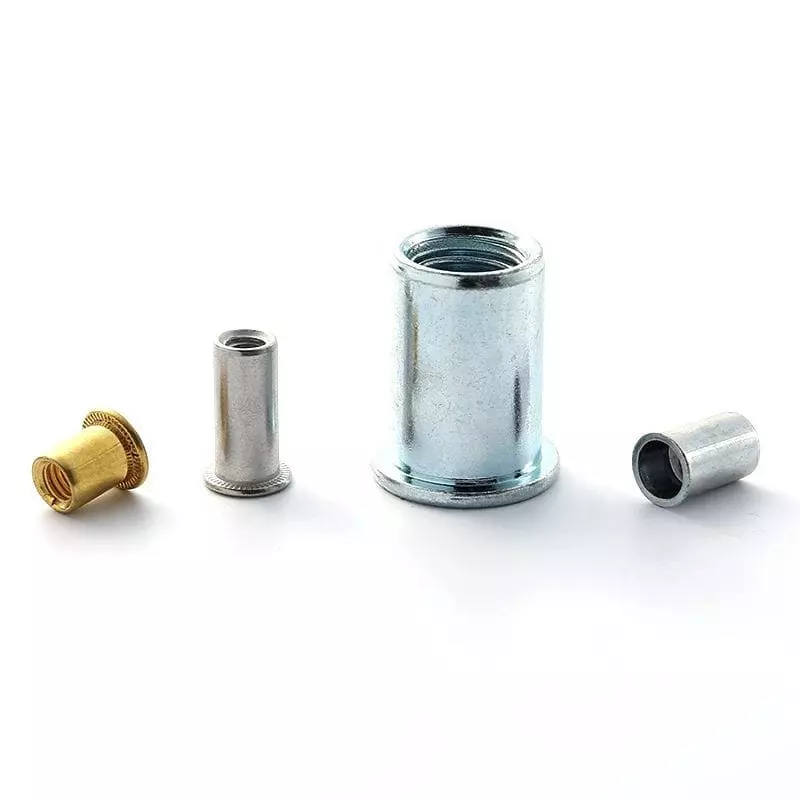
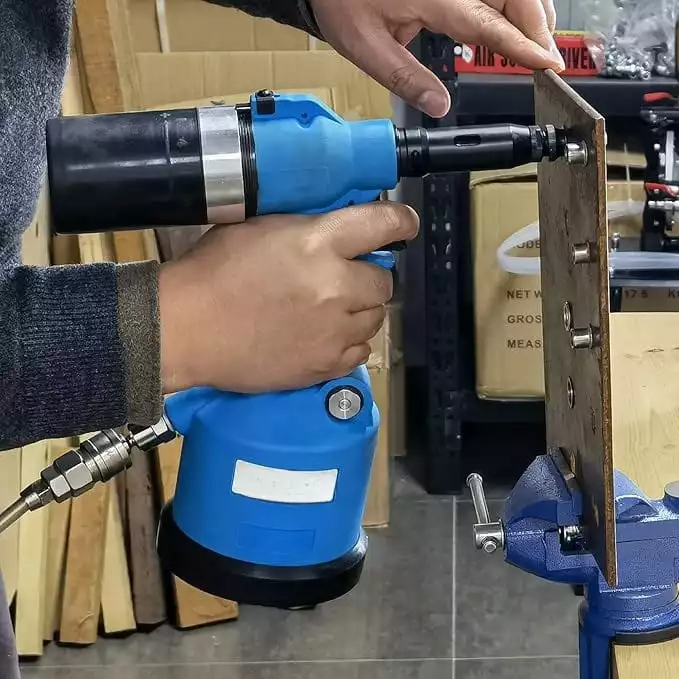
- Installation Method: Installed using a rivet gun, which pulls one end of the nut and compresses it into the material, forming a strong connection. Ideal for applications where access is only possible from one side or where pressing is difficult.
- Suitable Materials: Can be used in both finished and semi-finished materials, allowing installation from either side.
- Installation Requirements: Requires a specialized rivet gun.
- Applications: Suitable for areas where pressing is difficult, such as square tubes, round tubes, and other hollow structures. Rivet nuts also compensate for the limitations of welding.
- Advantages:
- Suitable for thicker base materials and maintains a nearly flush installation.
- Provides stronger threads, especially with hexagonal rivet nuts, which offer better resistance to spin-out.
- Available in various shapes and sizes, including floating thread options, offering greater flexibility.
Self-Clinching Nuts
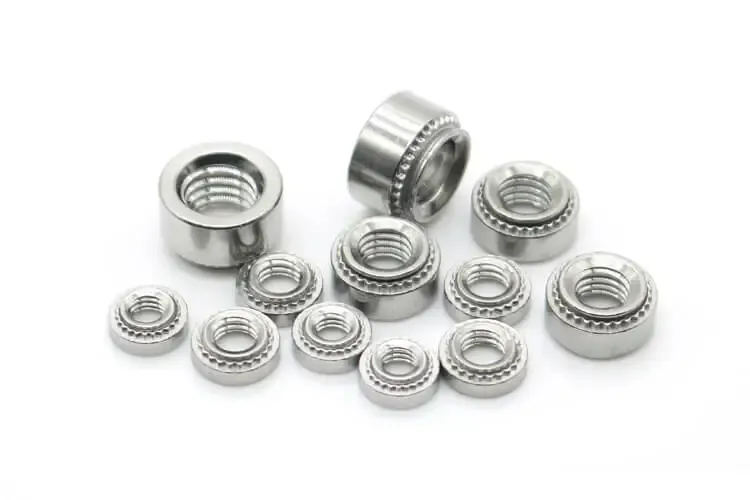

- Installation Method: Installed by pressing the nut into the sheet metal using a press, creating a secure threaded connection. Once installed, the surface remains flush without any protrusions.
- Suitable Materials: Typically used in semi-finished thin sheet materials, requiring pre-drilled holes before installation.
- Installation Requirements: Requires a press for installation, demanding high precision.
- Applications: Widely used in enclosures, cabinets, equipment manufacturing, and automotive industries, especially for thin sheet metal fastening.
- Advantages:
- Provides a flush surface after installation, ideal for compact designs.
- No special tools are required, and automation systems can be used for installation.
Summary
- Self-clinching nuts are ideal for thin sheet metal applications, providing a flush surface after installation. They are primarily used in semi-finished materials and require a press for installation.
- Rivet nuts are better suited for thicker base materials and can be used in both finished and semi-finished products. They require a rivet gun for installation and are ideal for hollow materials or applications where pressing is not feasible. Rivet nuts also offer stronger threads and greater installation flexibility.
Do You Have Any Questions?
Let Us Solve Your Problem
Why Buy Self Clinching Nuts from the Manufacturer?
Purchasing self-clinching nuts directly from the manufacturer offers significant advantages in cost-effectiveness, quality control, and flexible services, compared to sourcing through intermediaries. Buy PEM nuts online directly from the manufacturer can give your projects unmatched efficiency, cost control, and access to global suppliers.
1. Cost Advantage: Avoiding Distributor Markups
- Lower Unit Price: Eliminates distribution markups (typically 15%–30%), and bulk orders from manufacturers qualify for volume discounts (e.g., orders over 1,000 units may receive a 20% price reduction).
- Optimized Shipping Costs: Manufacturers often have strong logistics partnerships, enabling direct shipping at lower per-unit transportation costs (negotiated by tonnage or full-truck rates).
2. Quality Control: Eliminating Defects and Counterfeits
- Source Verification: Manufacturers provide material certifications (e.g., SGS reports) and production process standards (e.g., ISO 9001), reducing the risk of counterfeit or substandard products.
- Custom Quality Control: Specific testing requirements can be arranged, such as pull-out strength ≥8kN or salt spray resistance ≥500 hours, which intermediaries often cannot guarantee.
3. Flexible Customization: Meeting Non-Standard Requirements
- Specification Customization:
- Adjustable thread type (Metric/Imperial/Unified), material selection, and knurl depth.
- Optimized for thin sheets, such as a special flange design for 0.5mm aluminum panels.
- Material & Coating Customization:
- Corrosion Resistance: 316L stainless steel with double nickel plating, offering up to 1,000-hour salt spray resistance.
- Lightweight Options: Available in titanium alloy and high-strength aluminum alloy (e.g., 7075-T6).
Building Sustainable Collaboration with Rivetfix

With 15+ years of experience in fastener manufacturing, Rivetfix has grown into a trusted global supplier. Today, we have a dedicated team of 200+ skilled production workers and 40+ professional sales representatives, ensuring seamless service and reliable supply.
Our vision is simple yet powerful: to provide the highest-quality fasteners at competitive prices to customers worldwide. By combining precision manufacturing, efficient operations, and exceptional customer support, we are committed to helping businesses build stronger, more cost-effective solutions.
Partnering with Rivetfix means stable supply, top-quality fasteners, and custom solutions. We help you cut costs, boost efficiency, and enhance durability. Expect on-time delivery, expert support, and innovation. Let’s grow together!
Get High Quality Rivet Nuts Quote!
Send Your Rivet Nut Request
For more than 20 years, Rivetfix has helped customers solve many rivet nuts sourcing needs and technical challenges.
Have a question? Contact us and we’ll provide you with the perfect solution.

